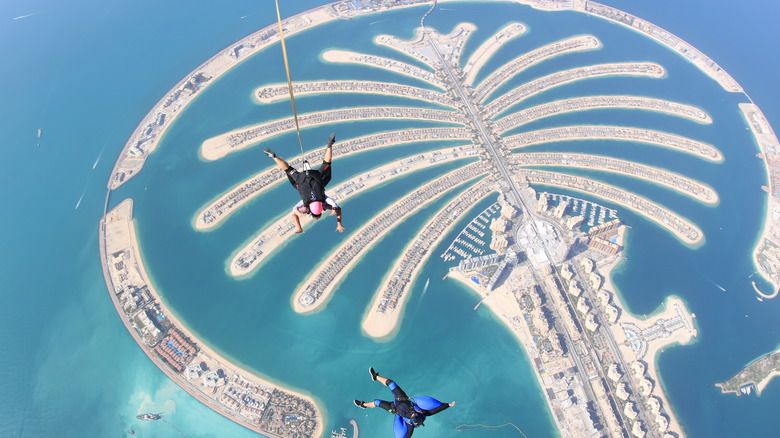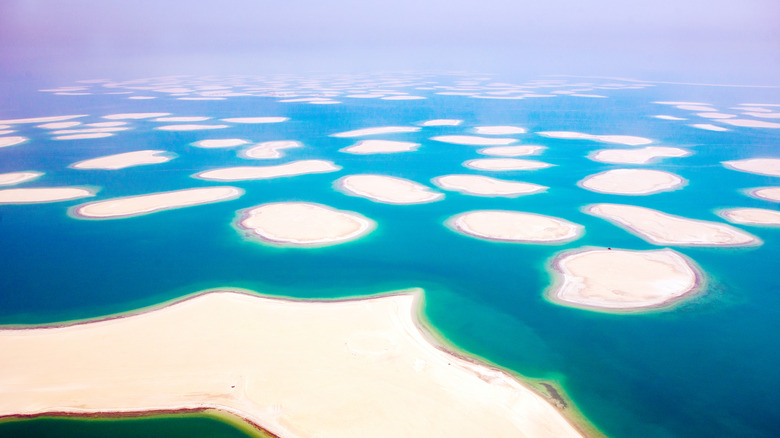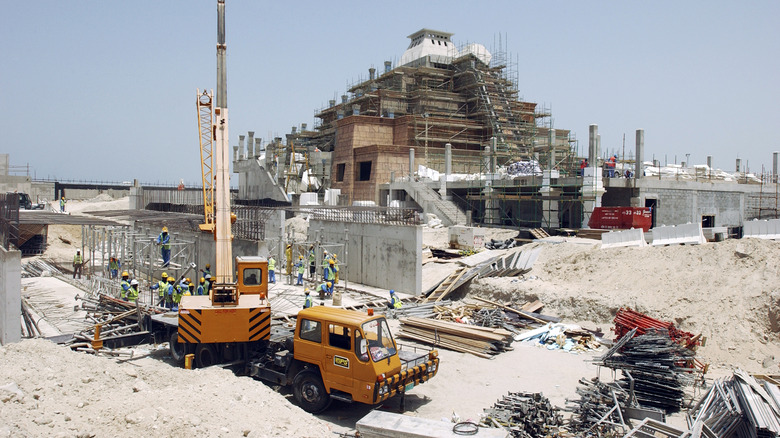Why Hardly Anyone Lives On Dubai's Man-Made Islands
If Dubai is anything, it's glamorous by design. Back in 1966 Sheikh Rashid bin Saeed Al Maktoum went all out to transform the historical fishing village into a gleaming desert idol founded on oil money, as Visit Dubai explains. Investors and upper-crust expats poured into the city year by year, and now Dubai's got indoor ski resorts, outdoor water parks, floating tennis courts, drone-controlled weather, and futuristic gardens. As a city built on literal shifting sands in the desert that requires mammoth resources to maintain and where temperatures exceed 115 degrees Fahrenheit, Dubai may also be a catastrophic cautionary tale waiting to happen.
The cracks in Dubai's foundation are clear and visible. Per the Carnegie Endowment for International Peace, 90% of Dubai's workers are low-wage laborers trafficked into the UAE from countries like India, Pakistan, and Bangladesh on promises of work. The Business and Human Rights Resource Center says that their passports are taken, they're shoved into tiny dormitories with minimal toilet facilities, left unpaid, and worse. Dubai's Burj Khalifa, the world's tallest building, doesn't even connect to a sewage system. Gizmodo reports that trucks queue for miles every day to haul away tons of waste from the building.
And then there's Dubai's artificial islands off the coast built by sand dragged up from the seabed. They're part of an ambitious plan to fashion homes and resorts for the ultra-wealthy. And now, as Tomorrow City says, they're largely abandoned, their market has collapsed, and they're already sinking into the sea.
A perfect storm of development troubles
Dubai's artificial island project involves five separate islands. There's the three palm islands, Palm Jumeirah, Palm Jebel Ali and Palm Deira, an archipelago of 300 small islands (pictured above) called "The World," and — just to up the ante — a final set of small islands configured after constellations called "The Universe." As Elite Traveler says, construction started in 2000 with the palm islands and was intended to create an oasis within the oasis of Dubai, containing more shops, more hotels, more resorts, more beaches, and more luxury goods. The palm islands even contain mansion-like homes built in wacky contemporary styles couched within gated communities and meant to mimic a lifestyle in the Hollywood hills, as the real estate site Dubai Palm Islands shows.
At present, as Tomorrow City explains, not one of the five islands is complete. Palm Jumeirah is the most developed and has functioning businesses, hotels, and homes on it. The other two palm islands are "rather underdeveloped, if not desolate." The Universe archipelago hasn't even gotten underway but is scheduled to finish by 2028. The World archipelago, meanwhile, has encountered one problem after the other during development, largely related to using sand from the ocean to build the islands. Erosion from wind and water has eaten away at the islands from day one while rising ocean levels threaten to consume them entirely. Then there's economic trouble, which kicked off in the financial crisis of 2008 and hasn't let up.
The sea reclaiming the land
If the generalities of Dubai's artificial islands seem disastrous, the details reveal how truly damned the entire venture really is. Tomorrow City explains that Palm Jumeirah — the only successfully populated palm island — is sinking at a rate of five millimeters per year. We're guessing that sand piled up from the ocean floor isn't all that good at sustaining the weight of tons of manmade structures, cars, and so forth.
Even as Dubai's islands sink, the ocean rises. The islands are surrounded by wave breakers a mere 6.5 feet tall, well below any meaningfully protective height. Water erosion also displaces between 353,000 and 530,000 cubic feet of sand per year, a figure set to rise as global warming makes ocean tides and weather more severe. Such environmental troubles have also led to legal troubles. Marine air-conditioning and refrigeration company Penguin Marine warned about erosion eating away at the islands and promptly got sued and silenced by Nakheel, the real estate company in charge of construction.
On top of all that, Dubai has contended with the aforementioned financial woes. Oil prices fell in 2014 following the financial crisis of 2008. In 2014 house prices also dropped by 14%, and then in 2018 real estate sales in the area fell by 46%. Certain companies like the Philippines-based Revolution Precrafted want to reinvigorate construction, but everything is slow going. For now, Dubai's artificial islands remain stuck in development hell, unfinished and baking in the sun.


